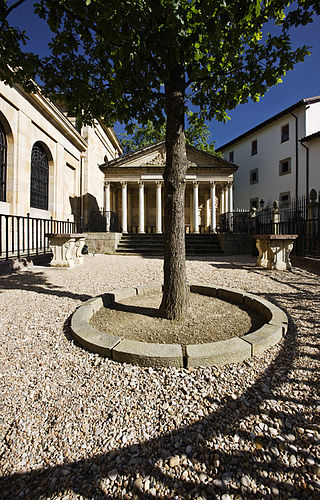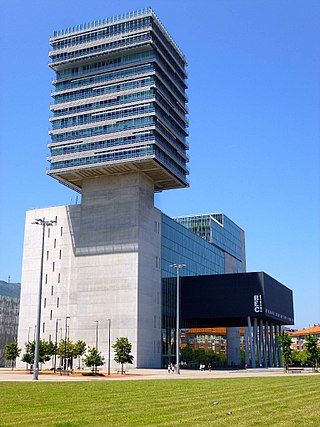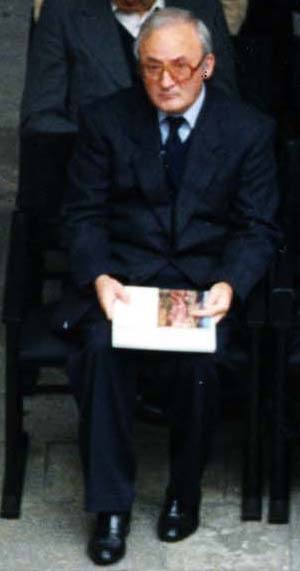
Guernica, officially Gernika in Basque, is a town in the province of Biscay, in the Autonomous Community of the Basque Country, Spain. The town of Guernica is one part of the municipality of Gernika-Lumo, whose population is 16,224 as of 2009.

Errenteria is a town located in the province of Gipuzkoa in the Basque Autonomous Community, in the north of Spain, near the French border. The river Oiartzun cuts its way through the town, one that has undergone severe pollution up to recent times on its lower stage.

Eibar is a city and municipality within the province of Gipuzkoa, in the Basque Country of Spain. It is the capital of the eskualde / comarca of Debabarrena.

Gipuzkoa is a province of Spain and a historical territory of the autonomous community of the Basque Country. Its capital city is Donostia-San Sebastián. Gipuzkoa shares borders with the French department of Pyrénées-Atlantiques at the northeast, with the province and autonomous community of Navarre at east, Biscay at west, Álava at southwest and the Bay of Biscay to its north. It is located at the easternmost extreme of the Cantabric Sea, in the Bay of Biscay. It has 66 kilometres of coast land.

Irun is a town of the Bidasoaldea region in the province of Gipuzkoa in the Basque Autonomous Community, Spain.

Karrantza Harana/Valle de Carranza, is a town and municipality located in the province of Biscay, in the Basque Country. It is located in the comarca of Enkarterri and it is the westernmost and largest municipality of the province.

Portugalete is a town lying to the west of Bilbao in the province of Biscay in the Autonomous Community of the Basque Country, northern Spain.

Barakaldo is a municipality located in the Biscay province in the Basque Country in Spain. Located on the Left Bank of the Estuary of Bilbao, the city is part of Greater Bilbao, has a population as of the 2019 census at 100,881. Barakaldo has an industrial river-port heritage and has undergone significant redevelopment with new commercial and residential areas replacing the once active industrial zones.

Mutriku is a coastal town located in the province of Gipuzkoa in the Autonomous Community of Basque Country in northern Spain. It has a population of around 5000 and provides access to the Bay of Biscay. It is the site of the world's first multi-turbine breakwater wave power station, opened July 8, 2011. The Church of San Andrés can be found here, being one of the oldest churches in Gipuzkoa, dating to the year 1080.

Pasaia is a town and municipality located in the province of Gipuzkoa in the Basque Autonomous Community of northern Spain. It is a fishing community, commercial port and the birthplace of the famous admiral Blas de Lezo and of the fashion designer Paco Rabanne.

Usurbil is a town and region located in the province of Gipuzkoa in the Autonomous Community of the Basque Country, in the North of Spain.

Erandio is a town and municipality located in the province of Biscay, in the autonomous community of Basque Country, northern Spain.

Ondarroa is a town and municipality located in the province of Biscay, in the autonomous community of the Basque Autonomous Community, northern Spain.

Juan María Lekuona Berasategi was a Basque poet in euskera.

Hernani is a town and municipality located in the province of Gipuzkoa, Basque Autonomous Community, Spain. The town sits on the left bank of the Urumea river. It is located at a distance of 9.2 km from San Sebastián. The municipality of Hernani occupies an area of approximately 40 square kilometres and is bordered by San Sebastián, Astigarraga, Arano, Elduayen, Errenteria, Lasarte-Oria and Urnieta.

Oiasso, Oiasona or Oiarso was a Vascon Roman (Civitas) town located on the left bank of the Bidasoa estuary in the Bay of Biscay. Archaeological evidence unearthed recently pinpoints the core area of Oiasso in the old quarter of Irun (Gipuzkoa) by the Spanish-French border, where harbour and bath remains have been discovered. However, two other focuses in Cape Higuer and hermitage Ama Xantalen point to a wider complex outside the main nucleus.

San Sebastián, officially known by the bilingual name Donostia / San Sebastián, is a city and municipality located in the Basque Autonomous Community, Spain. It lies on the coast of the Bay of Biscay, 20 km from the France–Spain border. The capital city of the province of Gipuzkoa, the municipality's population is 188,102 as of 2021, with its metropolitan area reaching 436,500 in 2010. Locals call themselves donostiarra (singular), both in Spanish and Basque. It is also a part of Basque Eurocity Bayonne-San Sebastián.

Aiako Harria in Basque or Peñas de Aya in Spanish, is a massif east of the town of Oiartzun in the Basque Country. The river Oiartzun rises on its north-western face.

The Oiartzun River is a short river in the Basque Country in the north of the Iberian Peninsula. It is the smallest river of Gipuzkoa flowing into the Bay of Biscay ; the river joins the sea at the Bay of Pasaia. The Oiartzun rises in the Aiako Harria massif at an altitude higher than 700 m. It flows down through steep slopes and falls, with an average drop to its mouth of 5.49%.
Oyarzún or Oyarzun may refer to:























